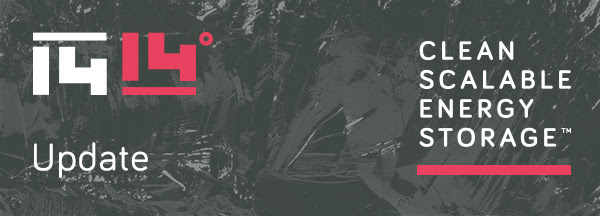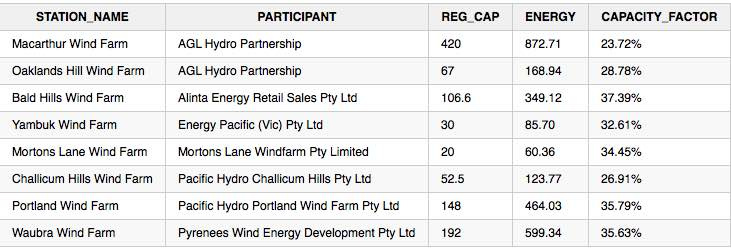Market driven activiity by BHP - it announced it will leave the World Coal Association and is reviewing its membership of the Minerals Council of Australia, in connection with the MCA approach to climate change.
Come in Trip.
So coal is reliable is it? When reality confronts the oft repeated sound bites.
Well it’s doing a hell of a lot better than our wind farms and they are not even ■■■■■■■ broken (apparently).
I had a long chat to a friend the other day, who is high up in strategic planning at AEMO. She had some interesting stuff to say.
First of all, AEMO’s main challenge isn’t having enough generation capacity to meet peak demand, it’s ensuring that demand matches supply.
Building more renewable generation is laudable an necessary, but it’s actually making things harder for AEMO at this point, because the infrastructure is not keeping pace and can’t support both it and increasingly unstable dinosaur coal generators. Renewables have changeable output, and as the above article shows the old coal generators are too junky to rely on in a pinch either (and they’re only going to get worse). That means that AEMOs main headache is having control over the generation capacity that they have, rather than more raw capacity. The current situation is kinda like plonking a F1 racer’s engine on a torana chassis and expecting to steer the resulting contraption with a set of handlebars off a pushbike.
Basically it’s a huge failure of federal energy policy, which has been ‘do nothing and make the states and renewable entrepreneurs put together a patchwork of differing systems and pile on renewable generation capacity if they want to address emissions in any way whatsoever, then don’t fund any method of connecting, managing, or tying them all together.’
The long-term switchover from fossil to renewable generation is going to happen and is already happening. Climate science demands it and now as the old coal plants close up economics will ensure it happens regardless of the desires of politicians or mining corporations or poor ■■■■■■■ coal miners in the Goulburn Valley who’ve been lied to about its viability for a decade plus. This is simple reality, deal with it. The only question is how it is best managed.
The real issue with power generation in the age of renewables is ensuring that supply matches (not exceeds!) demand at any given time. Blackouts happen when demand or supply spike or abruptly drop, triggering all sorts of failures to chain-react across the grid. This is what happened in SA last year - supply dropped abruptly when the wind blew those high-tension towers over and the rest of the system - while it had sufficient raw generation capacity to meet demand - couldn’t compensate fast enough to avoid a cascading failure (especially when there was a stuff up in communication and one of the gas plants that was meant to be on standby for this sort of thing didn’t do its job) The table in your post is true enough, but nobody at AEMO cares if wind farms are only producing at 25-30% max capacity all day - but they DO care if the a coal plant breaks down and goes from 100% to 50% capacity in an instant with no warning.
With renewables, there is a lot more variation on the supply side than there is with a fossil-fuel system in good working order. (In a crumbling relic fossil fuel system like ours this is not necessarily the case, because the supply tends to shit itself at unpredictable moments). A system with higher variability needs better control infrastructure to direct power where it’s needed. That’s what we haven’t currently got.
There’s degrees of variability too. Renewables tend to vary in a moderately predictable and smooth way - sure you have times when the wind doesn’t blow and the sun doesn’t shine across the entire state, but you’re likely to have a bit of warning (you don’t even need a day, an hour is more than plenty) so you can plan ahead for it. Also, the ramping up and trailing off of renewables tend to be gradual rather than immediate. On the other hand, when a rusty 1940s coal plant bursts a boiler and goes offline, you lose a large amount of generation capacity, instantly and with no warning, which is a lot harder to compensate for, and much more likely to cause a cascading failure n the grid.
To illustrate - AEMO is ALREADY planning ahead for I think it’s 2026, when a total eclipse will occur in the southern hemisphere resulting in every solar pv panel in Australia stopping generation abruptly in the middle of the day for a short period of time. You CAN do this sort of planning with renewables because fluctuations tend to be the result of predictable physical processes - Europe handled something very similar a year or so back.
I’m sure I’m getting some stuff wrong here because I don’t remember the entire conversation, but the big takeaway - finding enough sheer amount of generation capacity is not the real problem. Managing the power that has been generated is the real challenge.
Long story short, we need more variable, dispachable power rather than the whole lot coming from a few big clunkers that are extremely inflexible and prone to spontaneous failure.
Nah, not quite. That’s going to happen anyway, renewables are getting so cheap that sheer economics will see to it at this point even though the more useless and destructive among the political fraternity might try to hold it off with artificially imposed coal power quotas and subsidies and the like.
We need to be focusing on building a system for managing the grid that allows us to dispatch the dispatchable power we’re going to generate.
So, all the gold plated “investment” in poles and wires we are still paying for in inflated bills might end up coming back for another round?
I’m your biggest fan, but at risk of diminishing your mystique, you do realise those stats only reflect what is being asked of those stations to produce? As in if they needed to be running at 80% they could?
Not in this case it was an article highlighting the lack of output against what was wanted/expected.
Thanks for the compliment. There needs to be someone offering some sanity in a thread of make believe.
Not at all true. Capacity factors do not work that way in the slightest. Wind turbine depending on location are between 20-40% capacity factor. They are designed that way, so a turbine with a factor of 35% might be meetings it’s target. It’s not a case that it’s 65% under. An analogy would be a car that has a theoretical speed of 240km/h but you drive it at 100.
Careful.
Don’t want to cause any head explosions with all that actual knowledge about stuff, and things.

ASX in-principle approval
I am pleased to advise you that following a detailed submission to the Australian Securities Exchange (ASX), 1414 Degrees has received approval in-principle to proceed with submitting an ASX Listing application. Accordingly, we are drafting a prospectus and aim to submit it to ASIC in March 2018. The ASX code ‘14D’ has been reserved with ASX. In our first 12 months as a public company seed investors have subscribed for $6 million in shares and we have secured commitments from cornerstone investors for a substantial Initial Public Offering.
The prototype has continued to be used to refine configurations for the TESS-IND, the construction of which is progressing at our Research & Development site, however, there have been some delays from suppliers, and in shipping of the components which is pushing out the completion date. All parts for the storage module are expected on site by late February. The outer casing is arriving on site next week, so stay tuned to our social media accounts for updates.
We are excited to be heading into 2018 with an innovative project which recognises our technology’s potential. Planning is underway with client, SA Water, for a mid-2018 first stage installation of our new biogas combustion TESS at the Glenelg Wastewater Treatment Plant, supported by a $1.6m grant from the South Australian Government’s Renewable Technology Fund. With our help, SA Water is aiming to achieve a zero net electricity cost by 2020.
You can read more about the project here https://www.sawater.com.au/news/poo-puts-downward-pressure-on-power-costs.
1414 Degrees’ technology is unlike any existing energy storage, and the benefits of our technology are increasingly attracting commercial users, utilities, governments and investors to the versatile applications for electrical and heat outputs from our silicon energy storage.
Thank you for your interest in 1414 Degrees and I look forward to keeping you updated with our progress.
Dr. Kevin Moriarty
Executive Chairman
Over the last few days SA has given approval for the world’s largest solar thermal generator. Another first for Australia. They have pumped storage plans (500MW) as well as more wind farms and large solar in the pipe.
Victoria has a large battery and a number of large solar close to getting the green light. Actually the second most boring state in the country right now for renewable developments .
WA has a large battery and a number of large solar and biomass projects in the pipe.
Queensland is looking at a bigger battery than SA as well as solar thermal, more wind and large solar and pumped storage.
NSW is looking at large solar. 2000MW plant planned near Balranald. Bye Liddel.
That’s just now. This industry is gaining momentum faster than anyone can understand. Some pretty knowledgeable people are giving coal 10 years before it can’t even operate with subsidies. Gas to follow shoertly after as export market will still be using nearly all of it amd renewables will be cheaper even if it wasn’t. Obviously most of the coal generators will have been or will be at retirement age. I can’t wait for all the exasperated ranting from the politicised true believers when they either realise they’ve been lied to by paid up conservative charlatans or are so far up their own clackers they just keep developing conspiracies rather than facing the truth.
When are we likely to see cheaper power costs due to the renewables…
We might see lower power bills…but we’ll wonder why our taxes are rising.
And the answer will be that there is so much government investment going on that our power bills no longer reflect the full cost of supply.
That’s largely up to providers. Every chance the way to cheaper power will be after a capital expense on home solar and battery storage becoming the standard thing in some time.
Yeah, don’t hold your breath, unless you’re investing in your own.
Depends.
If the govt gets serious on a network designed to cope with renewable power, probably in a decade or two once the legacy stations are mostly gone.
If they don’t, it depends how lucky you are. If you can afford to put in the capital to buy a battery, probably in a few years. If you can’t, you’ll pay more and sucks to be you, because everyone who has spare capital (and owns their home) will be going off-grid and leaving the renters and similar poor suckers to foot the entire bill of maintenance of the poles and wires network.
^^And when that happens, the Tories will find some new tax so that off-gridders have to pay more anyway to keep the old tech going.
